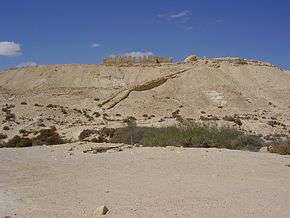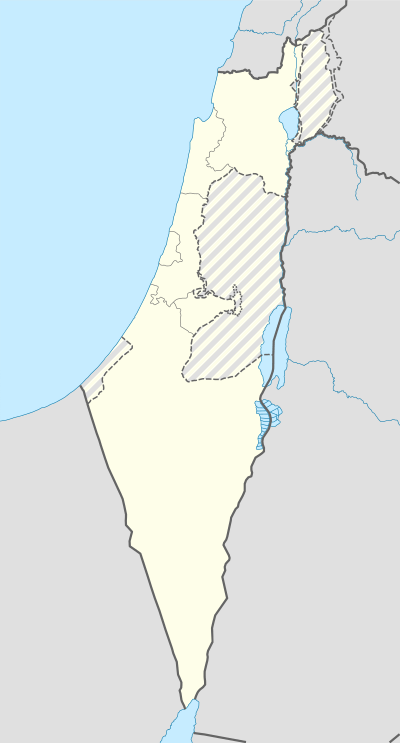Nitzana (Nabataean city)
| ניצנה | |
 Tel Nizana | |
 Shown within Israel | |
| Location | Southern District, Israel |
|---|---|
| Region | Negev |
| Coordinates | 30°52′34.03″N 34°25′58.20″E / 30.8761194°N 34.4328333°ECoordinates: 30°52′34.03″N 34°25′58.20″E / 30.8761194°N 34.4328333°E |
| Type | Settlement |
| History | |
| Founded | 1st century BCE |
| Abandoned | 7th century CE |
| Cultures | Nabataean, Roman, Byzantine |
Nitzana (Hebrew: ניצנה; transliterated at the site as "Nizana", Byzantine Greek Νιζάνα) is an ancient Nabataean city located in the southwest Negev desert in Israel close to the Egyptian border. It may have been a camel caravan station on the eastern branch of the ancient Incense Route, serving pilgrims and merchants travelling to Sinai or central Egypt. The Nabataean towns of the Negev were typically founded around the first century BC, conquered by Romans two centuries later, who garrisoned the site, and inhabited by Byzantine Christians from at latest the fourth century until the invasion and the Muslim conquest of Syria in the seventh century. Relatively few stones remain on the site because most were recycled into buildings in Gaza in the early 20th century.
Nessana papyri
During excavations in 1935-37,[1] a major trove of sixth- and seventh-century papyri in Greek and Arabic was discovered at this site, revealing a wealth of information about day-to-day life in Nabataean society between 505 and 689 CE, the last phase of Byzantine administration and the earliest phase of Arabic Islam. The papyri make this the best-documented of all the old Nabataean sites in the Negev.[2] The find sites were two store rooms in the ruined Church of Mary Mother of God and of the soldier saints Sergius and Bacchus. Private documents, such as wills, greatly outnumber official ones: a fragmentary text of Virgil and a Latin-Greek glossary of the Aeneid, fragments of the Gospel of John and early seventh-century church archives and the personal papers of a "George, son of Patrick", on the one hand, and archives of the military unit, "Numerus of the Most Loyal Theodosians" on the other.[3] Onomastics show that the largely Nabataean inhabitants of the city had become Christianized and Romanized in the early centuries CE, as well as documenting the arrival of a Byzantine phylarchate.[4] Many names of ancient cities in the Negev come only from these documents. One of the last of the papyri describes coinage struck and soldiers employed by 'Abd al-Malik, replacing the Roman institutions with a new Ummayad power structure.[5]
Gallery
-
German-Turkish hospital (1906-1917) built on ruins of Byzantine fort at Nizana. Note battle damage.
-
Remains of a Byzantine church at Nizana.
-

Ancient petroglyphs near Tel Nizana.
See also
- Nitzana – a modern-day village near the ruins
- Auja al-Hafir
References
- ↑ Excavations recommenced in 1987 under the direction of Dan Urman of Ben-Gurion University of the Negev. ontents of Excavations at Nessana, I (Harris Dunscombe Colt, ed. London, 1962); II, Literary Papyri (Lional Casson and Ernest L. Hettich, eds. Princeton, 1950.
- ↑ Irfan Shahîd, Byzantium and the Arabs in the Fifth Century, 1989:143: "III The Nessana Papyri".
- ↑ Contents of Excavations at Nessana, I (Harris Dunscombe Colt, ed. London, 1962); II, Literary Papyri (Lional Gasson and Ernest L. Hettich, eds. Princeton, 1950); III, Non-Literary Papyri Caspar J. Kraemer, ed. (Princeton, 1960); very brief summaries in Jodi Magness, The Archaeology of the Early Islamic Settlement in Palestine, vol. I: "Agriculture in the Nessana papyri" 2003:90f and Shahid 1989:143.
- ↑ Shahîd, Irfan (1989). Byzantium and the Arabs in the fifth century. Dumbarton Oaks. p. 143.
- ↑ Hoffman, Eva Rose F. (2007). Late antique and medieval art of the Mediterranean world. Wiley-Blackwell. p. 91.